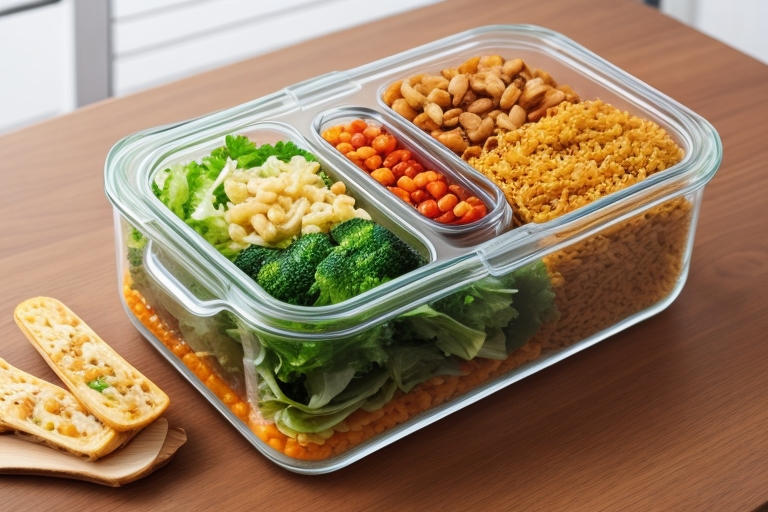
Choosing the right food containers for transporting food is crucial for several reasons. Firstly, suitable containers help maintain the quality and freshness of the food being transported. The right container can provide insulation, keeping hot foods warm and cold foods chilled, ensuring that they reach their destination at the optimal temperature.
Secondly, using appropriate food containers is essential for food safety. Containers that are designed for food transport are often made of materials that meet safety standards and are easy to clean and sanitize. This helps prevent the risk of contamination and ensures that the food remains safe for consumption.
Proper food containers help prevent spills and leaks, reducing the likelihood of cross-contamination between different food items. This is especially important when transporting various dishes or when dealing with allergens to avoid any potential health risks.
In summary, the choice of suitable food containers is vital for preserving food quality, maintaining food safety, and preventing contamination during transportation.
Factors to Consider When Choosing Food Containers
Choosing the right food containers for transporting food is crucial for several reasons. Firstly, suitable containers help maintain the quality and freshness of the food being transported. The right container can provide insulation, keeping hot foods warm and cold foods chilled, ensuring that they reach their destination at the optimal temperature.
Secondly, using appropriate food containers is essential for food safety. Containers that are designed for food transport are often made of materials that meet safety standards and are easy to clean and sanitize. This helps prevent the risk of contamination and ensures that the food remains safe for consumption.
Additionally, proper food containers help prevent spills and leaks, reducing the likelihood of cross-contamination between different food items. This is especially important when transporting various dishes or when dealing with allergens to avoid any potential health risks.
In summary, the choice of suitable food containers is vital for preserving food quality, maintaining food safety, and preventing contamination during transportation.
Different Types of Food Containers

Here’s a brief overview of the different types of food containers available in the market:
- Plastic Containers:
- Durability: Plastic containers are lightweight and durable, making them suitable for everyday use. However, they may not be as durable as glass or stainless steel.
- Insulation: Plastic containers are not great at retaining heat or cold, so they are more suitable for short-term storage or transportation.
- Ease of Use: They are generally convenient due to their lightweight nature and often come with secure, airtight lids.
- Examples: Tupperware, Rubbermaid, and Sistema are popular brands offering a variety of plastic food containers.
- Glass Containers:
- Durability: Glass containers are durable and resistant to scratches and stains. They are less prone to retaining odors compared to plastic.
- Insulation: Glass provides better insulation than plastic, making it suitable for storing both hot and cold foods.
- Ease of Use: Glass containers are heavier but can be used in the oven or microwave without concerns about harmful chemicals leaching into the food.
- Examples: Pyrex, Anchor Hocking, and OXO offer high-quality glass food storage containers.
- Stainless Steel Containers:
- Durability: Stainless steel containers are robust, resistant to rust, and less likely to break compared to glass or plastic.
- Insulation: They have excellent heat retention properties, making them suitable for keeping food hot or cold for extended periods.
- Ease of Use: Stainless steel containers are often dishwasher-safe and easy to clean. They are also lightweight and suitable for outdoor activities.
- Examples: LunchBots, U-Konserve, and EcoLunchbox are known for their stainless steel food containers.
- Insulated Containers:
- Durability: Insulated containers are designed with a double-wall construction, enhancing their durability.
- Insulation: These containers excel at maintaining the temperature of the food, keeping it hot or cold for an extended time.
- Ease of Use: They often come with secure lids and are suitable for transporting soups, stews, or beverages.
- Examples: Thermos, Hydro Flask, and Yeti offer popular insulated containers for various food and beverage items.
When choosing a food container, it’s essential to consider factors such as the intended use, durability, insulation needs, and personal preferences.
Considerations for Specific Types of Food

Here are specific considerations for transporting different types of food and recommendations for suitable containers:
- Liquids:
- Considerations: Liquids, such as sauces, dressings, or soups, require leak-proof containers to prevent spills and maintain the dish’s integrity.
- Recommendations: Opt for containers with secure, airtight seals. Brands like Sistema, Rubbermaid Brilliance, or Thermos offer leak-proof containers suitable for liquids.
- Soups:
- Considerations: Soups need containers that can maintain their temperature and prevent leakage during transportation.
- Recommendations: Insulated containers with a tight-sealing lid, like those from Thermos or Hydro Flask, are ideal for keeping soups hot or cold without the risk of spills.
- Salads:
- Considerations: Salads often include various ingredients, so it’s crucial to prevent sogginess by keeping wet and dry components separate until consumption.
- Recommendations: Bento-style containers with compartments, such as those from Bentgo or OXO Good Grips, allow you to keep salad ingredients separate until you’re ready to eat.
- Hot Meals:
- Considerations: Hot meals, like casseroles or pasta dishes, require containers that can retain heat and prevent heat loss.
- Recommendations: Use glass or stainless steel containers with secure, heat-resistant lids. Brands like Pyrex or LunchBots offer options suitable for transporting hot meals.
- Fruits and Vegetables:
- Considerations: Fruits and vegetables may release moisture, so it’s important to choose containers that prevent sogginess and maintain freshness.
- Recommendations: Ventilated containers or those with built-in drainage options, like Rubbermaid FreshWorks or Prep Naturals Glass Containers, can help keep produce fresh during transportation.
- Dry Snacks:
- Considerations: Dry snacks, such as nuts or crackers, need containers that protect them from crushing or becoming stale.
- Recommendations: Consider using small, airtight containers or snack-sized bags. Brands like Ziploc or Sistema offer compact and secure options for transporting dry snacks.
- Beverages:
- Considerations: Beverages, whether hot or cold, require containers that prevent spills and maintain the desired temperature.
- Recommendations: Insulated bottles or containers with spill-resistant features, like those from Yeti or Contigo, are suitable for transporting beverages.
Always check the specific features of containers, such as leak-proof seals, insulation properties, and compartmentalization, to ensure they meet the needs of the specific type of food you are transporting.
FAQs
- What material is best for food containers during transportation?
- Ideally, use containers made of sturdy materials such as BPA-free plastic, glass, or stainless steel. These materials are durable and safe for transporting various types of food.
- Are there specific containers suitable for keeping food hot or cold during transportation?
- Yes, insulated containers are designed to maintain the temperature of your food. Look for containers with double-walled insulation for heat retention or those with added features like gel packs for keeping food cold.
- Can I use regular plastic containers for transporting food?
- While regular plastic containers are okay for some foods, it’s recommended to use containers labeled as food-safe and free from harmful chemicals. Additionally, check if the container is microwave-safe if you plan to reheat the food.
- What features should I look for to prevent food spills during transportation?
- Opt for containers with secure, leak-proof lids. Snap-on lids or those with silicone gaskets can help create a tight seal, minimizing the risk of spills and keeping your food fresh.
- Are there size considerations when choosing food containers for transportation?
- Yes, consider the size of your portions and the available space in your transport bag or container. Choose containers that fit well together to maximize space and prevent food from shifting during transit.

Pingback: What Is The Best Container To Store Food In?
Pingback: Are Plastic Food Containers Harmful?